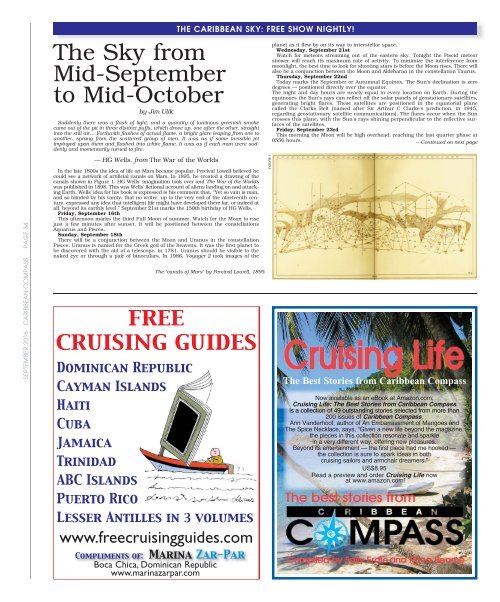Caribbean Compass Yachting Magazine September 2016
Welcome to Caribbean Compass, the most widely-read boating publication in the Caribbean! THE MOST NEWS YOU CAN USE - feature articles on cruising destinations, regattas, environment, events...
Welcome to Caribbean Compass, the most widely-read boating publication in the Caribbean! THE MOST NEWS YOU CAN USE - feature articles on cruising destinations, regattas, environment, events...
Create successful ePaper yourself
Turn your PDF publications into a flip-book with our unique Google optimized e-Paper software.
SEPTEMBER <strong>2016</strong> CARIBBEAN COMPASS PAGE 34<br />
The Sky from<br />
Mid-<strong>September</strong><br />
to Mid-October<br />
by Jim Ulik<br />
Suddenly there was a flash of light, and a quantity of luminous greenish smoke<br />
came out of the pit in three distinct puffs, which drove up, one after the other, straight<br />
into the still air… Forthwith flashes of actual flame, a bright glare leaping from one to<br />
another, sprang from the scattered group of men. It was as if some invisible jet<br />
impinged upon them and flashed into white flame. It was as if each man were suddenly<br />
and momentarily turned to fire.<br />
— HG Wells, from The War of the Worlds<br />
In the late 1800s the idea of life on Mars became popular. Percival Lowell believed he<br />
could see a network of artificial canals on Mars. In 1895, he created a drawing of the<br />
canals shown in Figure 1. HG Wells’ imagination took over and The War of the Worlds<br />
was published in 1898. This was Wells’ fictional account of aliens landing on and attacking<br />
Earth. Wells’ idea for his book is expressed is his comment that, “Yet so vain is man,<br />
and so blinded by his vanity, that no writer, up to the very end of the nineteenth century,<br />
expressed any idea that intelligent life might have developed there far, or indeed at<br />
all, beyond its earthly level.” <strong>September</strong> 21st marks the 150th birthday of HG Wells.<br />
Friday, <strong>September</strong> 16th<br />
This afternoon marks the third Full Moon of summer. Watch for the Moon to rise<br />
just a few minutes after sunset. It will be positioned between the constellations<br />
Aquarius and Pisces.<br />
Sunday, <strong>September</strong> 18th<br />
There will be a conjunction between the Moon and Uranus in the constellation<br />
Pisces. Uranus is named for the Greek god of the heavens. It was the first planet to<br />
be discovered with the aid of a telescope, in 1781. Uranus should be visible to the<br />
naked eye or through a pair of binoculars. In 1986, Voyager 2 took images of the<br />
FREE<br />
CRUISING GUIDES<br />
Dominican Republic<br />
Cayman Islands<br />
Haiti<br />
Cuba<br />
Jamaica<br />
Trinidad<br />
ABC Islands<br />
Puerto Rico<br />
Lesser Antilles in 3 volumes<br />
www.freecruisingguides.com<br />
Compliments of: Marina Zar-Par<br />
Boca Chica, Dominican Republic<br />
www.marinazarpar.com<br />
THE CARIBBEAN SKY: FREE SHOW NIGHTLY!<br />
The ‘canals of Mars’ by Percival Lowell, 1895<br />
FIGURE 1<br />
planet as it flew by on its way to interstellar space.<br />
Wednesday, <strong>September</strong> 21st<br />
Watch for meteors streaming out of the eastern sky. Tonight the Piscid meteor<br />
shower will reach its maximum rate of activity. To minimize the interference from<br />
moonlight, the best time to look for shooting stars is before the Moon rises. There will<br />
also be a conjunction between the Moon and Aldebaran in the constellation Taurus.<br />
Thursday, <strong>September</strong> 22nd<br />
Today marks the <strong>September</strong> or Autumnal Equinox. The Sun’s declination is zero<br />
degrees — positioned directly over the equator.<br />
The night and day hours are nearly equal in every location on Earth. During the<br />
equinoxes the Sun’s rays can reflect off the solar panels of geostationary satellites,<br />
generating bright flares. These satellites are positioned in the equatorial plane<br />
called the Clarke Belt (named after Sir Arthur C Clarke’s prediction, in 1945,<br />
regarding geostationary satellite communications). The flares occur when the Sun<br />
crosses this plane, with the Sun’s rays shining perpendicular to the reflective surfaces<br />
of the satellites.<br />
Friday, <strong>September</strong> 23rd<br />
This morning the Moon will be high overhead, reaching the last quarter phase at<br />
0556 hours. —Continued on next page<br />
The Best Stories from <strong>Caribbean</strong> <strong>Compass</strong><br />
Now available as an eBook at Amazon.com,<br />
Cruising Life: The Best Stories from <strong>Caribbean</strong> <strong>Compass</strong><br />
is a collection of 49 outstanding stories selected from more than<br />
200 issues of <strong>Caribbean</strong> <strong>Compass</strong>.<br />
Ann Vanderhoof, author of An Embarrassment of Mangoes and<br />
The Spice Necklace, says, “Given a new life beyond the magazine,<br />
the pieces in this collection resonate and sparkle<br />
in a very different way, offering new pleasures.<br />
Beyond its entertainment — the first piece had me hooked —<br />
the collection is sure to spark ideas in both<br />
cruising sailors and armchair dreamers.”<br />
US$8.95<br />
Read a preview and order Cruising Life now<br />
at www.amazon.com!


















